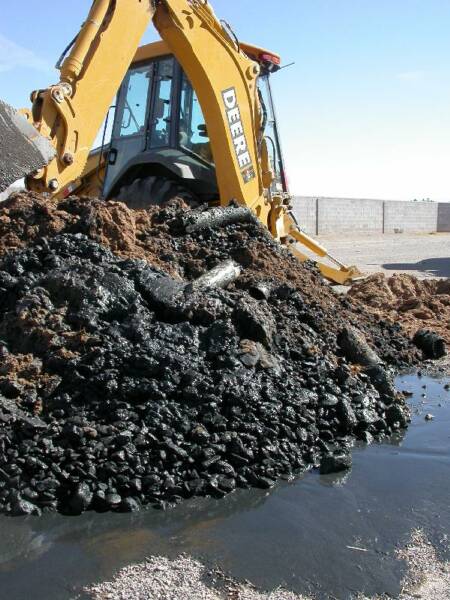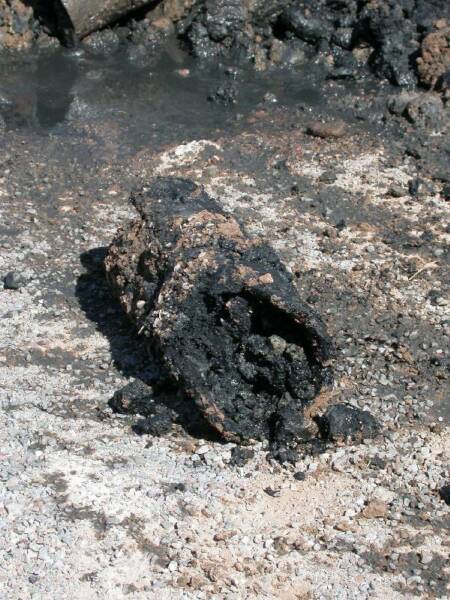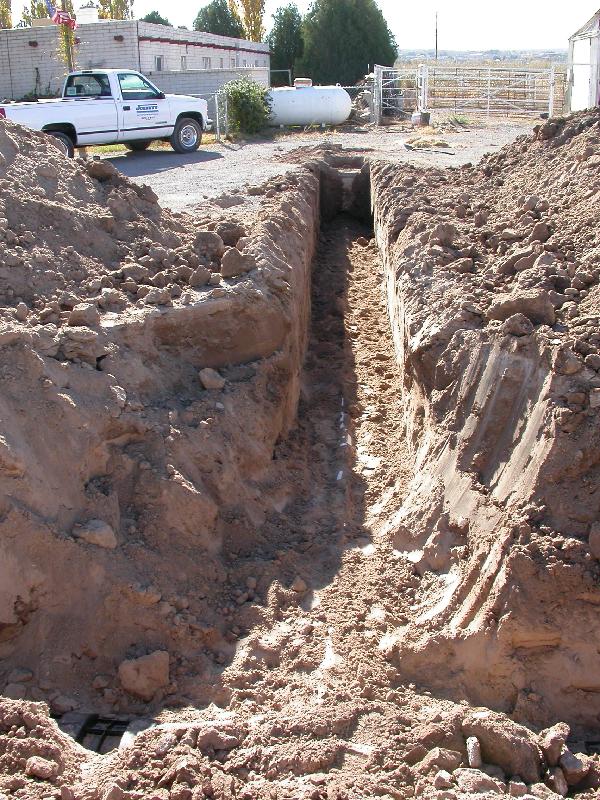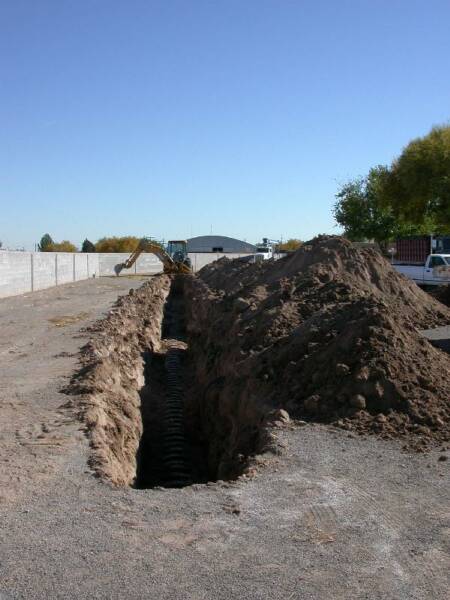The photographs to the top right are of a failed drainfield. The drainfield is contaminated with sludge, which can be caused by lack of pumping, use of heavy detergents and chemicals in the household, and a myriad of other reasons. The photographs below are of replacement drainfields being excavated.
Drainfield information :
JOHNNY'S SEPTIC TANK COMPANY
 | ||||||
575-526-5442
COMMON CAUSES OF DRAINFIELD FAILURE
University studies have shown that certain brands of detergents cause havoc with septic system drainfields. Some detergents have ingredients that bind with the lime in our area’s water and the sandy soil to form plaster. When this happens, the biomat that has formed on the bottom and sidewalls of the drainfield is literally smothered. (The biomat is the crusty layer of micro-organisms that processes the water from your septic tank). A common denominator with the more harmful detergents is a high amount of fillers. Also, certain detergents are extremely efficient in killing the bacteria that causes odors. The problem is, the naturally occurring bacteria in the drainfield can also be killed. Another concern is the quantity of detergent that is added to each washload. If detergent is used sparingly, it will still clean clothes, but it will be much less harmful to the drainfield. The only detergent that we recommend at this time that appears to be less harmful to drainfields is Liquid PUREX. PUREX has an extraordinarily low amount of fillers, it’s settling time is minimal compared to most detergents. This soap forms a very small amount of floating flocks and almost no settlement particles.
*Using heavy detergents, detergents with fillers, or excessive amounts of detergent with each wash load. (Low sudsing, concentrated, biodegradable detergents are best). We recommend Liquid PUREX detergent.
*Doing all the laundry in one day stirs up the solids in the tank and discharges them into the drainfield.
*Lint from synthetic clothing in wash water does not degrade and can contribute to sealing off the pores in the drainfield. These studies show that lint from one household's laundry for one year is enough to carpet an entire house. (Grey water can now legally be used to irrigate landscaping - call for more information).
*Liquid fabric softeners also tend to coat the soil of the drainfield and have a high concentration of quaternary ammonia; therefore we recommend dryer sheets. Please feel free to call our office with any questions you may have.
*Disposal of wipes such as "baby wipes" really creates havoc with the septic system and drainfield. We NEVER recommend disposal of these in the commode.
*Lack of pumping is the most common cause of drainfield failure. The sludge from the tank seals off the drainfield.
*Using more water than what the system was designed for. This can be checked by taking the gallons used in the winter months and averaging, then dividing by 30 days to get gallons per day. A 3 bedroom home should use no more than 375 gallons per day.
*Overgrowth of the biomat. This can be caused by a very starchy diet, high sugar diet, excessive nutrients going into the drain field. (This problem can be reduced by the use of a Zabel filter).
*A running commode or faucet, even if only for a few weeks. This can keep the sludge stirred up enough to discharge it into the drainfield.
*Discharging a jacuzzi or whirlpool tub tends to stir up the solids and discharge them into the drainfield.
*The air conditioner overflow draining into the tank. It could be constantly running undetected.
*Using the garbage disposal excessively. We recommend using it just for residue of food.
*Putting grease down the drain. This clogs the pipes and pores of the soil.
Flood irrigating over tank and/or drainfield. The silt from the field tends to get into the drainfield and seal it off. Also gophers create havoc by digging around drainfield so that irrigation water gets into it.
*Gas utility or other utility cutting off a drainfield lateral when it was installed.
*Extensive tree roots such as willow, mulberry, cottonwood, etc. These seal off the drainfield.
*Poor soil for drainage. This could be heavy soil that's not porous and doesn’t drain well, or sandy soil with little organic matter. The latter soil type doesn't have the microorganisms needed to consume the particles discharged into the drainfield, allowing the drainfield to be sealed off.
Heavy use of antibiotics or chemotherapy drugs over a period of time can completely kill off the productive drainfield bacteria.
*Overload by reverse osmosis water filter - they use between 3 - 5 gallons per every 1-gallon of water produced.
*Disposing of paint or washing paint pans and brushes in the household
can kill a drainfield.
*Excessive use of bath oils has been found to seal off a drainfield.
*Flushing flushable cat litter down the commode can seal off a drainfield.
*Heavy use of medications, such as chemotherapy etc. can literally kill a
biomat. It is important to pump the tank often with such treatments
in order to prevent this.
 | ||||||






